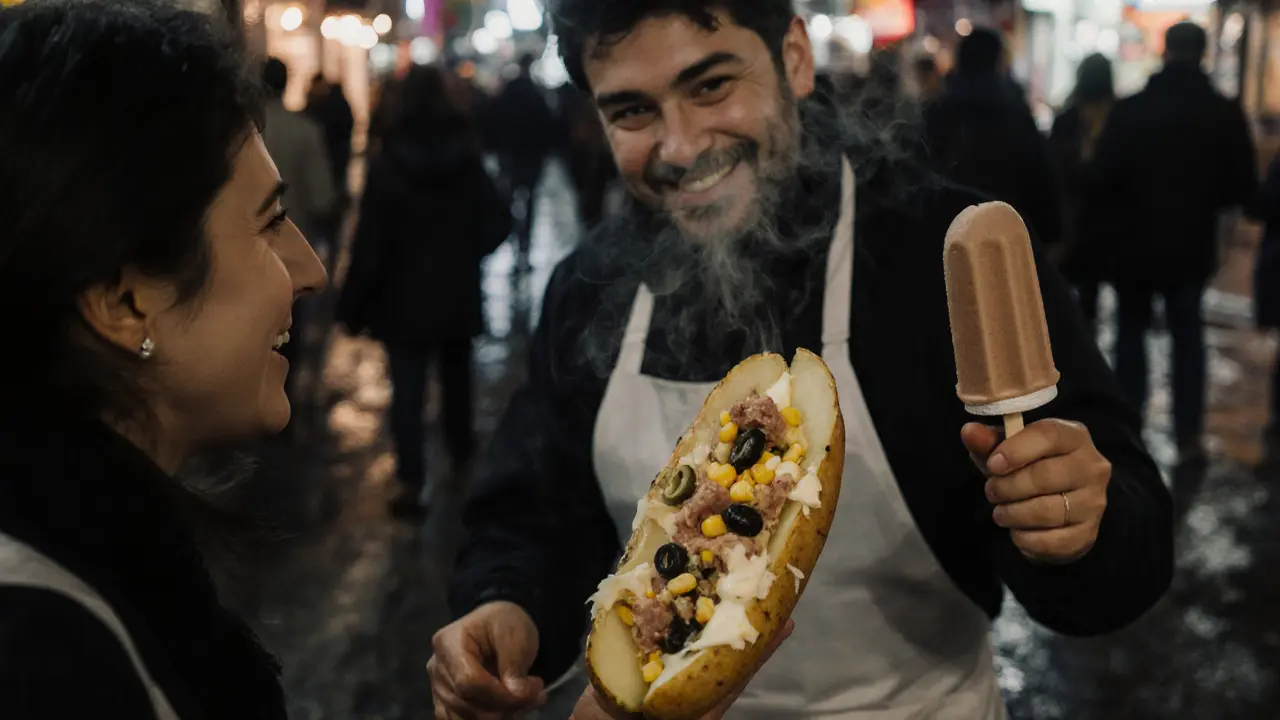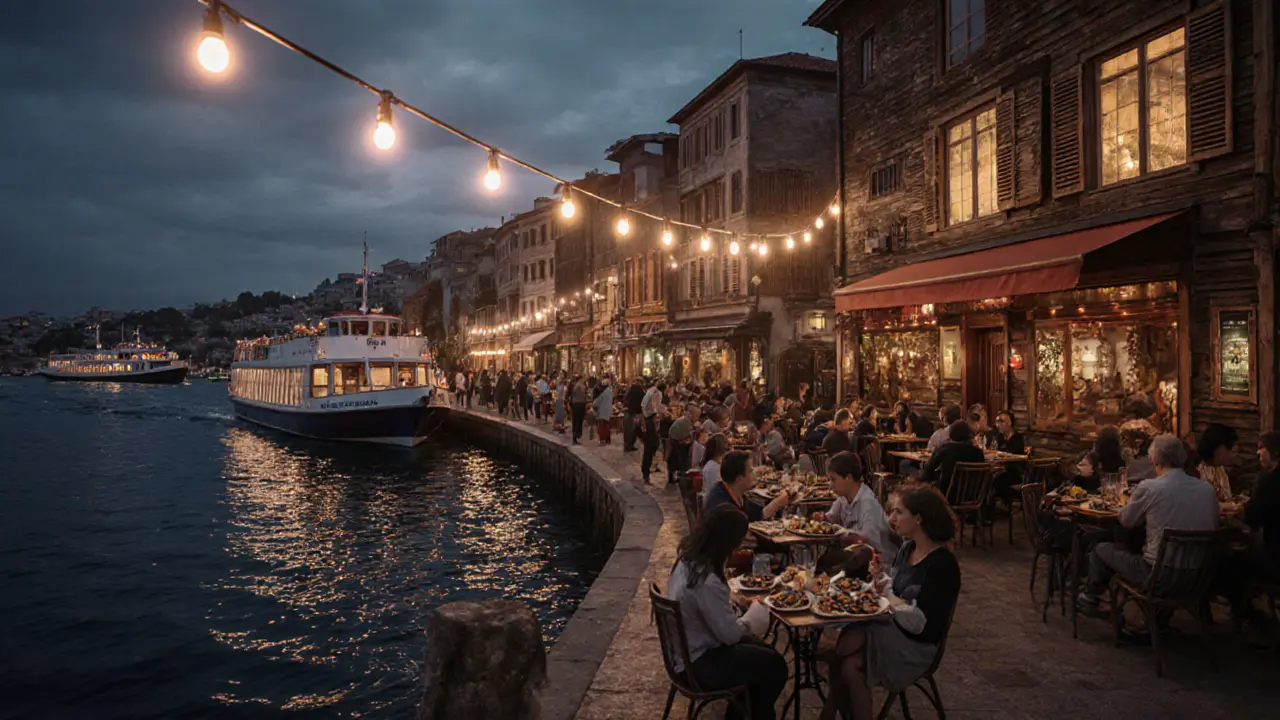When the sun sets over the Bosphorus, Istanbul doesn’t sleep-it transforms. The city’s nightlife isn’t just about drinking or dancing. It’s about slow sips of raki under string lights, the smell of grilled mackerel drifting from street carts, and the sound of ney flutes blending with bass-heavy beats in a hidden basement club. This isn’t a party scene imported from Berlin or London. It’s Istanbul’s own rhythm, shaped by centuries of trade, migration, and quiet rebellion.
Where the Night Begins: The Bosphorus Shoreline
Start your night along the water. The European side has its charm, but the real pulse beats on the Asian side in Kadıköy. Here, old wooden houses with shuttered windows now hold craft cocktail bars, vinyl record shops, and tiny mezze spots where locals gather after work. Walk along the waterfront promenade, and you’ll see groups of friends sharing a plate of midye dolma-stuffed mussels drizzled with lemon and chili flakes-while watching ferries glide past with glowing windows.
Unlike tourist-heavy areas like Taksim, Kadıköy feels lived-in. There’s no bouncer checking your ID at 11 p.m. No velvet ropes. Just a bar owner who knows your name by the third visit. The vibe? Relaxed, unpretentious, and deeply local. Try Bar 1907 for a glass of natural wine and smoked eggplant dip, or Yeni Lokanta for lamb kebabs cooked over charcoal until the edges crisp like candy.
The Raki Ritual: More Than a Drink
If you want to understand Istanbul’s night, start with raki. It’s not just an alcoholic beverage-it’s a social contract. The ritual begins with a small glass, ice cubes clinking, water poured slowly until the clear liquid turns milky white. It’s served with meze: sliced tomatoes, cucumbers, feta, stuffed grape leaves, and fried calamari. No one drinks raki alone. It’s always shared, always slow.
Bars like Asitane in Beyoğlu or Çiya Sofrası in Kadıköy turn raki nights into multi-hour feasts. You’ll sit for two hours, maybe three, talking about football, politics, or the latest Turkish drama. The conversation flows as easily as the drink. Don’t rush it. This isn’t a shot bar. It’s a conversation with flavor.
From Underground Clubs to Rooftop Jazz
By midnight, the city splits into two worlds. One leads to clubs where electronic music pulses through concrete walls. The other to quiet jazz lounges where piano notes hang in the air like incense.
On the European side, Reina and Karaköy Lokantası draw international crowds with DJs spinning house and techno. But the real gems are the smaller spots: Yasak Muzik in Karaköy, tucked below a Turkish bath, where the bass is deep but the crowd is intimate. Or Alaçatı in Nişantaşı, a velvet-lined lounge where live jazz blends with the sound of rain tapping the glass ceiling.
On the Asian side, Bar 22 in Kadıköy hosts experimental Turkish electronica, mixing saz lutes with synth loops. It’s not loud. It’s layered. Like the city itself.

Street Food After Midnight
After dancing or sipping wine, hunger hits. That’s when Istanbul’s street food comes alive. Head to Çiğdem Sokak in Kadıköy or İstiklal Caddesi after 1 a.m., and you’ll find vendors flipping simit (sesame-crusted bread rings), grilling lahmacun (thin Turkish pizza), and frying balık ekmek (fish sandwiches) with pickled onions and parsley.
One of the most iconic late-night bites? Kumpir-a baked potato split open and loaded with butter, cheese, corn, olives, pickles, and tuna. It’s messy. It’s delicious. And it’s the only thing that makes sense after three hours of dancing.
Don’t miss the dondurma vendors. Turkish ice cream, made with mastic and salep, doesn’t melt easily. It’s chewy, elastic, and often served with a playful tug-of-war between the vendor and the customer. It’s not just dessert. It’s performance art.
The Quiet End: Tea, Tobacco, and Midnight Conversations
Most nights don’t end with a club closing. They end in a tiny tea house, where the lights are dim, the chairs are worn, and the conversation never stops. Places like Çayır Çay in Beyoğlu or İstanbul Kahvesi in Beşiktaş stay open until 5 a.m. or later.
Here, people talk about everything: the price of bread, the future of the city, the last election, the new Turkish film everyone’s talking about. No one checks their phone. No one rushes. The tea is strong, sweet, and endless. A single cup lasts two hours.
This is the real nightlife of Istanbul-not the Instagrammable bars, not the neon signs, not the viral TikTok dances. It’s the quiet moment after the music fades, when the city exhales, and you realize you’ve spent the night not just eating or drinking, but connecting.

What to Avoid
Not all nights in Istanbul are created equal. Avoid the tourist traps in Taksim Square after 2 a.m. The bars there are overpriced, loud, and impersonal. The bouncers are aggressive. The music is the same playlist you’d hear in any European capital.
Also skip the so-called "Turkish night" shows in hotels. They’re performances, not culture. Real Turkish music isn’t staged. It’s played in backrooms, on rooftops, and in alleyways where no one’s selling tickets.
And never order a "Turkish cocktail" unless you know what’s in it. Many are just cheap vodka with syrup and a cherry. Stick to raki, wine, or local beers like Efes or Kübra.
When to Go
Spring (April-June) and fall (September-November) are the sweet spots. Summer is too hot for long walks. Winter can be rainy, but the crowds thin out, and the locals are more welcoming. Friday and Saturday nights are busy, but Tuesday and Wednesday? That’s when the real locals are out. Go then, and you’ll feel like you’ve been let in on a secret.
Final Tip: Dress Like a Local
There’s no dress code in Istanbul’s nightlife-except one: don’t look like a tourist. No baseball caps, no fanny packs, no flip-flops. Locals dress simply: dark jeans, a good jacket, clean sneakers. Women wear scarves, but not for modesty-because it’s stylish. Men skip the cologne. Too much smells like a hotel lobby.
Walk slowly. Look around. Talk to the barkeep. Ask what’s good tonight. They’ll tell you. And if you’re lucky, they’ll invite you to join them for another round.
Is Istanbul nightlife safe for solo travelers?
Yes, Istanbul’s nightlife is generally safe for solo travelers, especially in areas like Kadıköy, Karaköy, and Beyoğlu. The streets are well-lit, and locals are often helpful. Avoid isolated alleys after 2 a.m., and don’t carry large amounts of cash. Public transport runs until 3 a.m., and taxis are cheap and reliable. Trust your gut-if a place feels off, leave.
Do I need to speak Turkish to enjoy Istanbul’s nightlife?
No, but knowing a few phrases helps. Most bartenders in popular areas speak basic English. But if you say "Teşekkür ederim" (thank you) or "Ne önerirsiniz?" (What do you recommend?), people respond with warmth. Many of the best spots are small, family-run places where English isn’t spoken. A smile and a point at the menu go a long way.
What’s the best time to visit Istanbul for nightlife?
The best months are April to June and September to November. The weather is mild, the crowds are smaller, and the energy feels more authentic. Summer is packed with tourists, and winter nights are quiet-great if you prefer a slower pace. Avoid major holidays like Ramadan or Eid, when many places close early or have limited hours.
Are there any female-only nightlife spaces in Istanbul?
Yes. Places like Çiçek Pasajı in Beyoğlu and Women’s Cafe in Kadıköy are run by women and cater to female travelers and locals. They offer safe, welcoming spaces with live music, poetry nights, and tea-based cocktails. No pressure to drink alcohol. Just good company and quiet conversation.
How much should I budget for a night out in Istanbul?
You can have an unforgettable night for under $30. A raki and meze platter costs about $10. Street food like kumpir or balık ekmek is $3-$5. A cocktail at a craft bar runs $6-$8. Public transport is $0.50. If you skip the expensive clubs and stick to local spots, you’ll spend less than most tourists expect-and get far more authentic experiences.
